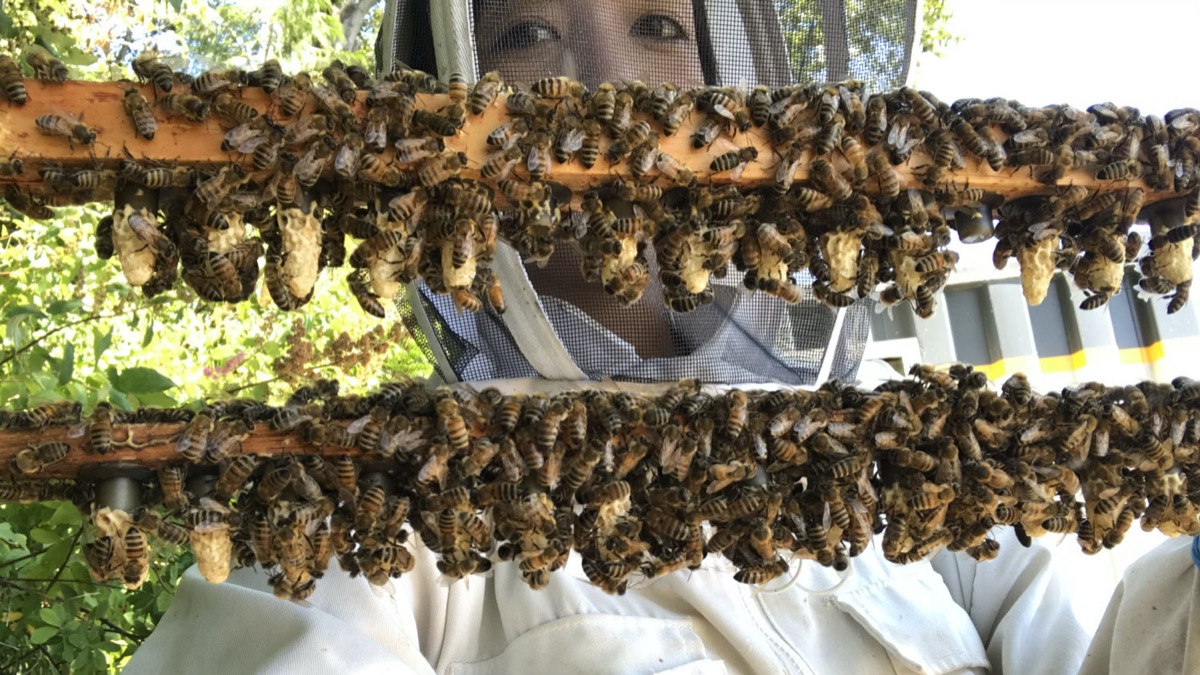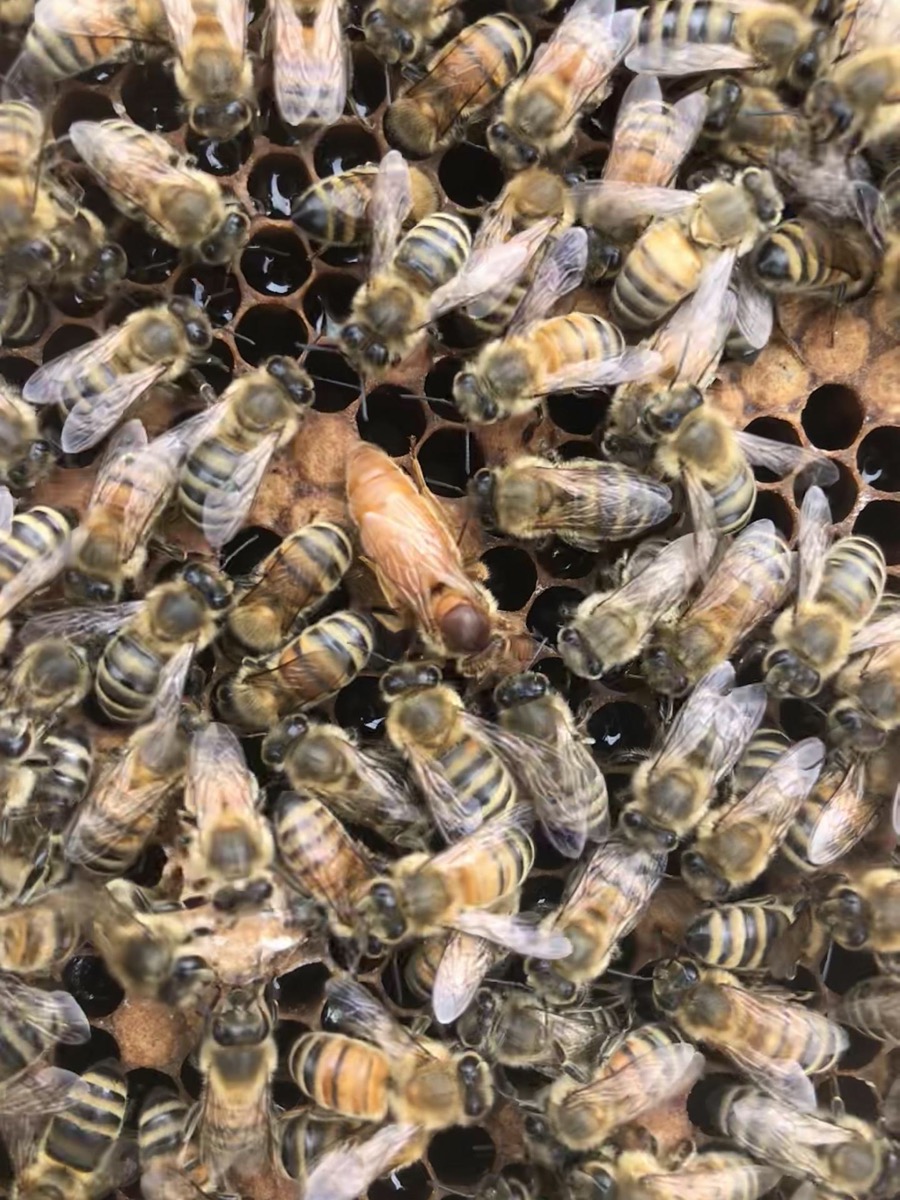A Reproductive Mystery In Honey Bee Decline
8:59 minutes

As global honey bee decline continues through yet another decade, researchers have learned a lot about how complicated the problem actually is. Rather than one smoking gun, parasites like the varroa mite, combined with viruses, pesticides, and other factors are collectively undermining bee health to an alarming degree.

One part of the mystery is the increasing rate of ‘queen failure,’ when a reproducing queen is no longer able to produce enough fertilized eggs to maintain the hive. When this happens, beekeepers must replace the queen years before they ordinarily might.
Producer Christie Taylor talks to North Carolina State University researcher Alison McAfee about one possible reason this may occur—a failure to maintain the viability of the sperm they store in their bodies after a single mating event early in life. The condition may be caused by temperature stress, immune stress, or a combination of factors. McAfee explains this problem, plus the bigger mystery of how queens manage to keep sperm alive as long as they do.
Invest in quality science journalism by making a donation to Science Friday.
Alison McAfee is a postdoctoral researcher at North Carolina State University and University of British Columbia in Vancouver, British Columbia.
IRA FLATOW: This is Science Friday. I’m Ira Flatow. We’ve talked for years about the crisis agricultural honey bees have been facing– whole colonies dying over the winter and steep declines in population over the last decades. And as with lots of stuff in science, the closer scientists look at what’s causing this disappearance, the more complicated it gets. Sci Fri producer Christie Taylor has more involving a key hive member, honeybee queens.
CHRISTIE TAYLOR: Something I just learned this week is that honeybee queens only made once in their entire lifetimes. Once she’s done, she’s storing all the sperm she’ll ever need inside her body for up to as many as five years, somehow keeping it alive. But what happens when she can’t keep that sperm alive as long as usual? Here to talk about that process and new research on what factors may end a queen’s reproductive life prematurely is Dr. Alison McAfee, a postdoctoral researcher at North Carolina State University and the University of British Columbia. Hey there, Alison.
ALISON MCAFEE: Hello, Christie.
CHRISTIE TAYLOR: Like I said, I just learned this thing about Queens this week and I’m still kind of marveling that they can keep all this sperm that they need to create an entire colony alive for all those years. This feels like a pretty incredible feat. How do they do it?
ALISON MCAFEE: That is a big question. That is the reason why I’m doing the research I’m doing, because it’s such a fascinating feat of biology. They have a very specialized storage organ called the spermatheca which actually looks something like a little pearl that’s maybe half the size of a pinhead. And it is inside her abdomen. And when she mates, that becomes maybe half full of sperm and the other half is full of this stuff called the spermathecal fluid, which is like a bath that keeps the sperm happy for years and years to come.
CHRISTIE TAYLOR: This seems a lot more complicated than all of the processes that male bees or mammals even would go through to produce sperm.
ALISON MCAFEE: Yeah, it’s very challenging because of the extreme length of time that she has to keep them alive for. So ants actually do the same thing. And they are even more extreme than honeybees. They’ll keep sperm alive for decades even. But it means that the queen then has a pretty big responsibility to somehow keep the sperm from being damaged, keep the effects of environmental stressors at a minimum. It’s a very challenging thing to do. They’ve been under very strong selective pressure to optimize these systems.
CHRISTIE TAYLOR: But as I was saying, they don’t always keep the sperm alive and happy that whole time. Sometimes it goes wrong. And that’s what you’re researching?
ALISON MCAFEE: Yeah, I think of my research as like I’m playing queen detective these days. Sampling all the honeybee queens that I can from beekeepers who are willing to give them to me. And measuring all the things I can about them to try to figure out why they’re actually failing.
So one of the results we’ve found is that queens that are rated as failing by beekeepers have significantly lower sperm viability or more dead sperm stored inside them than healthy queens. And so I’m really interested in all the kinds of factors that can lead to that sperm death. And there appear to be quite a few.
CHRISTIE TAYLOR: Such as?
ALISON MCAFEE: Temperature stress is the first thing that I looked at. And that’s maybe not all that surprising because actually hot temperatures at least are known to kill sperm in all kinds of different animals, including humans. So it’s not a big deal for a mammal because you can produce more sperm. But a honeybee queen is stuck with all the sperm that she got early in life and she can’t go acquire more if it starts to die.
So hot temperatures is one of them. Cold temperatures also which is worrying because queens are very vulnerable to temperature changes when they are shipped all around the world. So there’s actually a worldwide queen distribution system that beekeepers in many places, including Canada, where I am right now, rely on. So when they’re shipped, they’re exposed to, or they’re vulnerable to essentially whatever the ambient environment is.
And pesticides, you might guess, are another factor affecting sperm viability. Some people have shown that when you actually apply a pesticide to a queen that the sperm she’s stored start to die then as well.
CHRISTIE TAYLOR: And so your most recent research was looking specifically at some of the biochemistry of molecules that queens have in their systems when their sperm is either in good shape or in bad shape. What are those clues too for you?
ALISON MCAFEE: Yeah, so our most recent research has started looking at the impacts of pathogen infections, specifically viruses. The failed queens, they’re essentially more sick. They have higher levels of a couple of different viruses in them.
And in those same queens, we also find that they have, as you might expect, an elevated immune response. So they are producing more of these proteins that help them normally fight infections. And what it’s looking like is happening, or at least the data are very consistent with these other well known ideas in reproductive biology, that there’s essentially a trade off between how fertile you are and how well you can fight off infections.
So if you launch an immune response against some pathogen, you may have to do that in order to stay alive essentially. But that is an energetically costly activity. And so by launching that response, you have to take resources away from something else, assuming that there’s a finite amount of resources, which there usually is. And in the case of the queen, that something else would be reproduction because that’s what she is normally spending the vast majority of her resources on. She actually lays her own body weight equivalent of eggs every day. So you can–
CHRISTIE TAYLOR: Holy cow.
ALISON MCAFEE: –you can imagine the energetic cost involved in reproduction for her.
CHRISTIE TAYLOR: Do you think that this knowledge about sort of the effect on sperm viability is something we can use to save honeybees from possible extinction?
ALISON MCAFEE: I mean, it’s clearly one piece of a very large puzzle. But it is something that we can actually do something about thankfully. So I mentioned that queens are vulnerable to temperature stress during shipping. And it could be something as simple as just changing the kind of containers or cages that we ship queens in.
Something that I’m also worried about though is that climate scientists are predicting more heat waves in the future. So that worries me because we have done some work where we place temperature loggers inside colonies during heat waves. And we find that it actually gets surprisingly hot inside there.
So that’s worrying. But thankfully that’s also something we can do something about. We can change the materials that we actually have the bees in.
CHRISTIE TAYLOR: Any time we talk about honeybee decline, it can get to be feeling kind of depressing just in terms of what it says about ecosystems that we’re dependent on. But I just want to go back to how amazing it is that under normal conditions, queen bees are able to put a living sperm cell into deep storage for five years. That’s a technology that human beings only kind of figured out in the last 50 or 60 years. So can we learn from honeybee queens things that might assist our understanding of reproductive science in the wider animal kingdom?
ALISON MCAFEE: I think so. That’s one of my main goals in my research, is to get to a place where I can actually try to somehow recapitulate this complicated system that the queens have come up with in their spermatheca to be able to store sperm of hopefully any animal on the bench quite easily and for a long period of time so that we can study more things about what keeps them alive. It took humans a while to figure it out, as you mentioned. But queens don’t even rely on cryopreservation. They do this all just regular temperatures. So that makes it even more remarkable.
CHRISTIE TAYLOR: Amazing. Well, I think that’s all the time we have. I’m so sorry. Thank you so much for joining me, Alison.
ALISON MCAFEE: Yeah. Thank you very much for having me.
CHRISTIE TAYLOR: Dr. Alison McAfee, postdoctoral researcher at North Carolina State University and the University of British Columbia. She joined me from Vancouver. For Science Friday, I’m Christie Taylor.
Copyright © 2021 Science Friday Initiative. All rights reserved. Science Friday transcripts are produced on a tight deadline by 3Play Media. Fidelity to the original aired/published audio or video file might vary, and text might be updated or amended in the future. For the authoritative record of Science Friday’s programming, please visit the original aired/published recording. For terms of use and more information, visit our policies pages at http://www.sciencefriday.com/about/policies/
Christie Taylor was a producer for Science Friday. Her days involved diligent research, too many phone calls for an introvert, and asking scientists if they have any audio of that narwhal heartbeat.